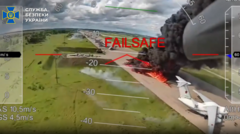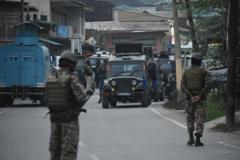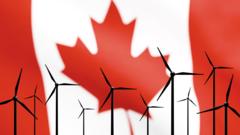A recent study reveals that making simple modifications to flight paths could significantly reduce the climate-damaging effects of jet contrails, with costs as low as £4 per flight. Experts emphasize the need for clarity amidst conspiracy theories surrounding contrails and urge actionable solutions at the upcoming UN climate conference.
Innovative Solutions Proposed for Jet Contrails' Climate Impact

Innovative Solutions Proposed for Jet Contrails' Climate Impact
New research highlights affordable strategies to mitigate the warming effects of contrails as aviation experts prepare to discuss this at COP29 in Baku.
Article Text:
The detrimental impact of jet plane contrails on climate change could be minimized through straightforward actions, according to aviation experts who are set to present a new study at the UN climate conference, COP29, in Baku. The researchers contend that addressing the issue of contrails is not only feasible but also cost-effective, costing merely a few pounds per flight.
Contrails, or condensation trails, have generated numerous conspiracy theories claimings they contain harmful substances. However, scientists assert that the genuine concern lies in the warmed air trapped by these trails, which amplify the heating effect associated with aviation’s carbon emissions. “These trails effectively create an artificial cloud cover, producing an environmental impact comparable to aviation’s fossil fuel usage,” explained Carlos Lopez de la Osa from the Transport & Environment initiative.
While the existence of contrails has been acknowledged for years, their role in climate warming has only become a focus in recent times. The COP29 conference aims to shine a light on potential changes in aviation practices that could significantly alleviate the adverse effects associated with contrails.
The study indicated that approximately 80% of the contrail-related warming is attributed to just 3% of flights. Minor adjustments in flight paths—considering temperature, humidity, and specific altitudes—could reduce contrail warming by over half by 2040 at a modest cost.
Contrails are most prevalent when planes fly over colder climates, particularly in regions like North America and Europe, where the majority of contrail warming occurs. Notably, flights that take place during evening and nighttime hours contribute the most to warming, particularly during winter months.
“While pilots currently navigate around thunderstorms, integrating contrail avoidance into flight route planning will be necessary,” Lopez de la Osa stated. The researchers are hopeful that their findings will resonate at COP29, showcasing an inexpensive yet impactful strategy for climate change mitigation.
As discussions at COP29 progress, experts continue to emphasize the significance of adapting aviation practices, encouraging investments in sustainable aviation fuels while spotlighting the viability of tackling contrails to promote meaningful environmental benefits.
The detrimental impact of jet plane contrails on climate change could be minimized through straightforward actions, according to aviation experts who are set to present a new study at the UN climate conference, COP29, in Baku. The researchers contend that addressing the issue of contrails is not only feasible but also cost-effective, costing merely a few pounds per flight.
Contrails, or condensation trails, have generated numerous conspiracy theories claimings they contain harmful substances. However, scientists assert that the genuine concern lies in the warmed air trapped by these trails, which amplify the heating effect associated with aviation’s carbon emissions. “These trails effectively create an artificial cloud cover, producing an environmental impact comparable to aviation’s fossil fuel usage,” explained Carlos Lopez de la Osa from the Transport & Environment initiative.
While the existence of contrails has been acknowledged for years, their role in climate warming has only become a focus in recent times. The COP29 conference aims to shine a light on potential changes in aviation practices that could significantly alleviate the adverse effects associated with contrails.
The study indicated that approximately 80% of the contrail-related warming is attributed to just 3% of flights. Minor adjustments in flight paths—considering temperature, humidity, and specific altitudes—could reduce contrail warming by over half by 2040 at a modest cost.
Contrails are most prevalent when planes fly over colder climates, particularly in regions like North America and Europe, where the majority of contrail warming occurs. Notably, flights that take place during evening and nighttime hours contribute the most to warming, particularly during winter months.
“While pilots currently navigate around thunderstorms, integrating contrail avoidance into flight route planning will be necessary,” Lopez de la Osa stated. The researchers are hopeful that their findings will resonate at COP29, showcasing an inexpensive yet impactful strategy for climate change mitigation.
As discussions at COP29 progress, experts continue to emphasize the significance of adapting aviation practices, encouraging investments in sustainable aviation fuels while spotlighting the viability of tackling contrails to promote meaningful environmental benefits.





















